#ladies garments online
Explore tagged Tumblr posts
Text
https://www.nairaland.com/8066589/exploring-diversity-indian-traditional-dress
#sama didi#Indian traditional dress for ladies#women kurti set with dupatta#kurti dupatta set for women#Online kurtis for women#Sama garments
2 notes
·
View notes
Text
Buy Most Demanded High Quality Silk Fabric Online In Australia
Do you want to purchase high-quality silk fabric in Australia? We are manufacturers and suppliers of premium-grade woollen, silk and other textile products in Australia. Our extensive range of women's fashion, menswear and casual wear is available in different styles, colours and sizes. We use only the finest materials and the latest designs to manufacture our products. Our designers work hard to ensure that our collection is stylish, versatile, comfortable and affordable. Contact us for more details about high quality silk fabric online.

#wellbeing garments australia#sustainable wool yarn australia#sustainable fashion australia#sustainable wool sweaters#high quality knitwear online#high end women's scarves australia#designer scarves for women australia#australian made knitwear#knitwear australia#women's luxury designer clothing#mens crew neck jumper#womens sweaters australia#mens designer clothes online#ladies online clothing stores australia
9 notes
·
View notes
Text
Jones, a leading clothing manufacturer, crafts premium innerwear, t-shirts, shirts, and leisurewear for men, women, and kids with unmatched quality and style. for more details: jonesindia.in/
#clothing manufacturer#clothing shop#kid clothes#clothing producers#clothing manu#shop clo#shops with clothes#kiddies clothing#clothes sale#clothing factory#design clothes#trendy clothes#stitch clothes#clothing design#online boutiques#online shops#dress store#cloth shop#and online shopping#clothes bags#online shopping sale#online clothes sale#wear clothes#cloth manufacturer#garments shop#on line shops#indian clothes manufacturer#season clothing#online shopping for ladies clothes#clothes and shopping
1 note
·
View note
Text

Fold Over Gunmetal Trim Long Length Link Chain Fashion Hardware Accessory
#jhoneaaccessories
#accessories#fashion clothing accessories#accessoriesforwomen#accessoriesformen#premium accessories#metal accessories#online accessories#metaltrims#metal pieces#fashiondesigner#tumblr fashion#womens fashion#ladies fashion#celebrity fashion#fashion design#fashionable#clothingaccessories#fashion accessories#garment accessories#onlineaccessories#onlineorder#buy online
1 note
·
View note
Text

#custom tshirts#satin dress#dress#women's garments#ladies clothing#online shopping#sketer#skater dress
0 notes
Text
Sexism in TOS: Worst Offender, or Progressive in Retrospect in Comparison?
I see a lot of folks claim that TOS was the most sexist of the Star Trek shows by a landslide -- and while I agree that it definitely suffered from the sexism of the times, I also have other perspectives to share to give some food for thought.
I am of course not insinuating that TOS isn't sexist -- it is, but I have to ask folks to consider the breadth and depth of Berman's sexism in his run and ask yourself: Was Gene Roddenberry genuinely more sexist in his storytelling and delivery than Rick Berman?
I'm not telling you to feel one way or the other, but all I ask is that you hear me out and consider some perspectives and make your own balanced assessments. Nobody is obligated to share my opinion, but it means a lot just to have folks hear it and see their thoughts on the subject. So here is what I was originally responding to:
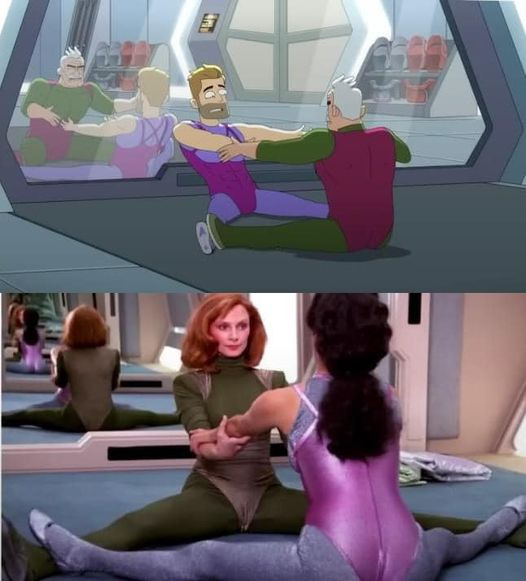
Someone's response to this photo:
"Devil's advocate. This was a part of the popular form of cardio during the production time of TNG. Yes, it was heavily sexualised by men, but so is literally every other way women work out. Men have been caught taking pictures of women while trying to do dead lifts, running on tracks and working on sled machines. They post them online to share too. The fact is, there is no way a woman can be shown working out without it going there. And yeah,t hat includes the combat forms of workout they do in Star Trek. Just look at how Dax dresses when she spars with Worf. Yes, they're dating, but still, same goes when 7 does and any other female.
Aerobics routines like this were made dirty and cringy. This was what women wore then by and large. This is how the workout was done. We make it cringy."
My response to them:
"I respect your take, but I disagree on a few fronts.
The miniskirt was chosen by the TOS female cast, not the male cast, specifically requested by Grace LW and affirmed by Nichelle and Majel who would go on to vehemently defend the miniskirt over the years as comfortable and embraced by them.
Grace said it was comfortable and seen as a symbol of female sexual empowerment during the 60s and thought it would be a progressive garment (and turns out that it was, as it was later adapted and worn by male crew as a skant on TNG) -- FYI those were designed by a gay man and Gene approved them.

This was also supposed to be Spock's TMP outfit:
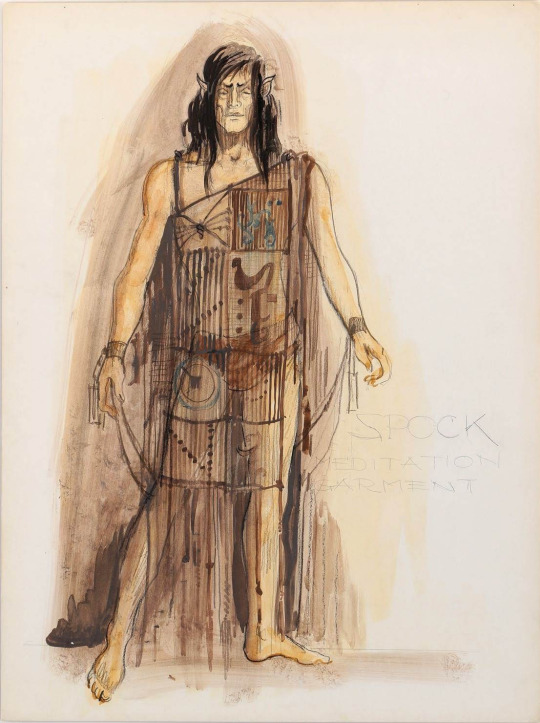
Literally lingerie.
We saw both Uhura (who saves Kirk in from Marlena Mirror Mirror) and Yeoman Landon (the first to initiate combat with a classic Kirk-esque kick to help the Captain being attacked in The Apple) carry out their combat training in their Starfleet uniforms without ever being made to change into any ridiculous workout gear.
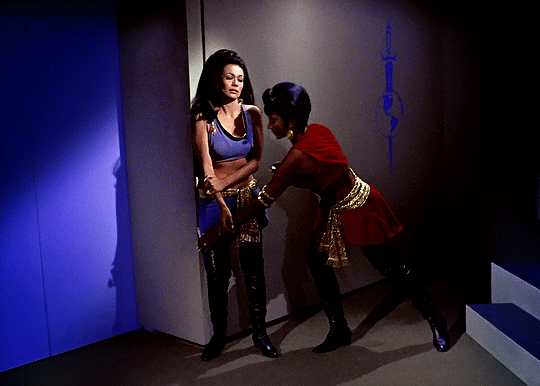



In fact, I'd argue Jim Kirk was sexualized even more than the ladies of the week on the show and I saw his naked body more than anyone else's on a fairly regular basis. He wore red yoga tights while topless in Charlie X while the women wore full length gymnastic suits that covered their entire body. If anything, it went out of its way to avoid sexualizing women practicing fitness in those scenes and instead focused on Kirk.
Gene confessed that he asked to have Shatner filmed in suggestive/provocative ways to "give something to the ladies", so he -- as he said -- liked to "film him walking away" or have him conveniently busting out of his shirts in just about every episode as it were, because Shatner apparently had great assets. LOL


Gene made an effort to at least sexualize both if he was going to sexualize one, and he carried that attitude forward in wanting the m/m and f/f scenes in the background on Risa for TNG. He also insisted that the men and women wear skimpy outfits on THAT TNG planet. You know the one. LOL I mean the dudes even had on less than the women:
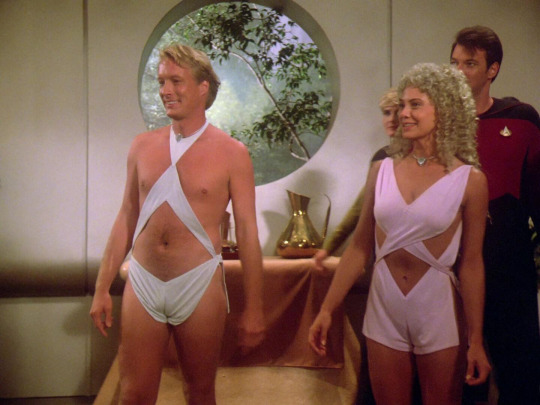
Gene also gave permission to K/S shippers to have their conventions back in the 70s when he was asked for permission. Gene and Nimoy felt with all the skimpy outfits they had the ladies wear, why not let the ladies and gay men have their fun, too? It's how we ended up with moments like this:
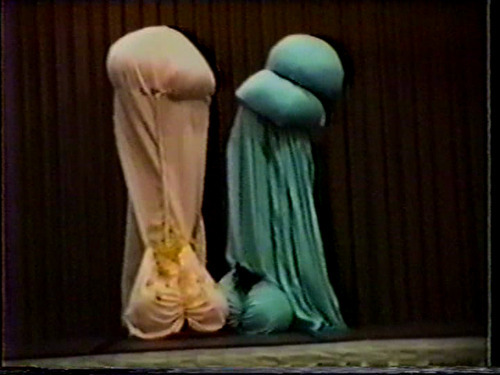
Yes, those are two people dressed up as Kirk and Spock's penises doing interpretive dance. Gene didn't give two damns. LOL
In my eyes, that was a very progressive take on Gene's part for the 60s. It was actually PARAMOUNT STUDIOS who had the big problem with K/S stories and vehemently tried to shut them down. Gene literally hired slash authors on his payroll and even had several slash stories/writers published in his official Star Trek books (The New Voyages & The New Voyages II).
I feel I saw Uhura and women in TOS engaged in more physical combat/altercations defending themselves that Troi or Bev were shown holding their own.
In fact, Kirk used to get furious when someone would "dress up" his female crew members without their consent (Trelane episode, Shore Leave episode) because like his male crew members, he wanted them to be treated professionally and to also have his male crew act professionally.
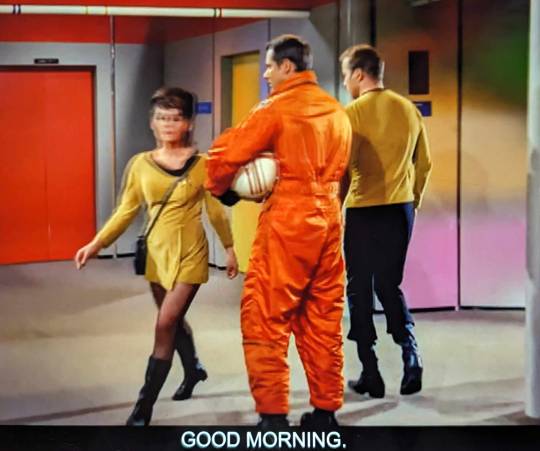

Berman brought some of his own personal biases into Star Trek that in some ways regressed it. While TOS had blatant sexism and was called on it time and again, that show was made in the 60s -- a solid 21 years before TNG. We as a modern audience understood why some of it was cringe/sexist due to the time period -- look at any other media coming out in the 60s and Star Trek was miles ahead of what other shows were doing.
Compare that to Berman who was churning sexist stuff out when women like Starbuck and Scully were simultaneously on screen on other programs airing, and we had already had Sigourney Weaver and other strong women in Holywood playing respectful roles.
In my eyes, there was no need of the sexism seen in TNG but especially VOY and ENT. There was no excuse for it when other shows were writing women far better and a number of those weren't even set in the future like Trek was, making it age even faster due to having those dated perspectives frequently highlighted.
In the Center Seat documentary as well as "The Fifty Year Mission" book you will find cast members, writers and other studio alumni who attest to this. Some discussions from "The Fifty Year Mission":
"First, Berman was supposed to have been a real sleaze ball . . . According to Terry Farrel, he would go on constantly about how her breasts weren't big enough, how she should do something about it, and how his secretary was a good example to follow as she had huge breasts. She even had to have fittings to get larger bras, and that was all done at his behest.
Later Berman and Braga developed a name for Jeri Ryan's character prior Seven of Nine. They originally called the character "perineum" which if you look it up it is the area between the anus and the scrotum. Later they floated the name "6 of 9". I mean, what does it tell you about where these two were coming from in the development of this character if they had names like that put forward in all seriousness for her?"
Gene Roddenberry also had some of his own more progressive ideas for TNG cut or watered down by Berman. Roddenberry agreed TNG should have homosexual relationships and representation at a con in the 80s and insisted on it in a meeting with his writers -- something Berman later would not honor. Gene wanted the AIDS episode, showing m/m and f/f in the Riza scenes -- these were some of Roddenberry's requests to include in TNG that Berman later stonewalled.
Berman's era was sadly dated by his own misogynist bias, IMO, to the point that it can somewhat hurt the shows he worked on through his cringe egoism and blatant disrespect toward his female cast.
There is a reason why Gene could keep female actresses working with him and Berman had a revolving door of women that he couldn't seem to keep working for him -- he was abhorrent to women, on and off set. Gene wasn't perfect at all, he had a lot of issues himself -- but Berman was a whole other level. Just look at what he did to poor Jolene Blalock, Marina Sirtis and his toxic commenting on her body weight which exacerbated her struggles with eating disorders, or how he treated and talked to Terry Farrell.
Anyway, just some food for thought. I'm not saying anyone is wrong regarding a take like that, but there are a variety of ways to look at this. Gene Roddenberry isn't a saint by any means, but it definitely bothers me how folks will tote the Berman era as if it were the lesser of two evils or the more progressive depiction of women when I felt there were far more concerning portrayals of women in his era with far less justification.
(P.S: I don't event want to go near the sheer amount of "creepy old dude/villain preys on innocent/naïve/scared young woman or little girl" stories there were in Berman's era, either. But that's a whole other can of worms I can write about in a part 2.)
#star trek#star trek tos#star trek tng#star trek voy#star trek ent#star trek ds9 was the one show that went above and beyond#1shirt2shirtredshirtdeadshirt#oc#octrekmeta#octrek#gene roddenberry#rick berman#brannon braga#kirk#spock#uhura#rand#nichelle nichols#majel barrett#grace lee whitney#tos#tng#voy#ent#marina sirtis#jolene blalock#terry farrell
4K notes
·
View notes
Text
I've been wanting to do this post for a while now so here is EVERYTHING I CAN TELL YOU ABOUT THE GHOULS' IMPERA COSTUMES.
Buckle up because I have a LOT to say about those, this is gonna be a very long one.
The costumes were designed by B Åkerlund, a Swedish costume designer who's worked with Ghost since at least Meliora (that's as far back as I was willing to scroll on her Instagram page lol). B Åkerlund has also worked for many other musical artists such as Lady Gaga, Beyoncé, Madonna, the Rolling Stones, Ozzy Osborne, Blink 182 and Hollywood Undead (information from her own website)

The masks were made by Bob Basset, a visual artists who works a lot with leather. I find his work fascinating, you can look him up on Instagram (nsfw warning, there's a few naked ladies).
Fun fact! The horns are real cow horns. That's the reason some of them have gold tips, to hide the imperfections that come with working with actual horns.
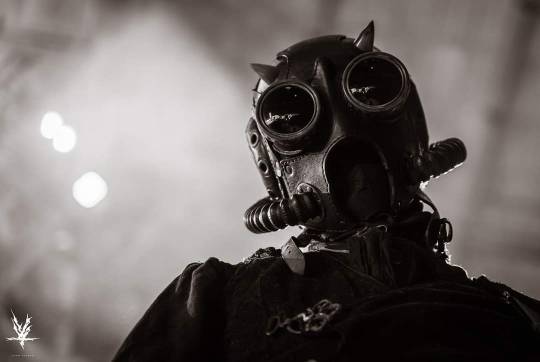
He does have a shop where he sells his items, there's a mask there very similar to the Impera ones. You can also buy Papa's batwings if you happen to have 2500$ lying around!

The jackets are made on the same model as one of Papa's. The back is decorated with a spine-like design made from leather and cording. It's adorned with a few of our classic Impera buttons. Some of the hems were left raw and some deliberate weathering was done to make it look old and worn.
Fun fact! The shoulder pieces are not sewn into the garment, I would assume for easier cleaning. I don't know if they're held by strong magnets or snap buttons.
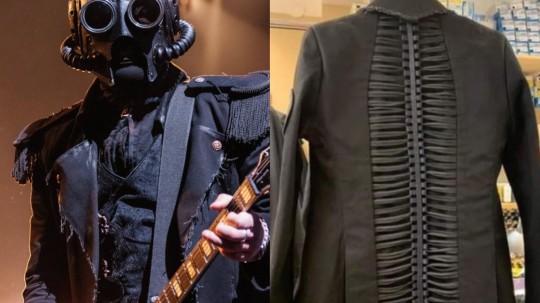
The vest (my beloved 😩) is made from flocked velvet in a paisley pattern, the front hems embellished with satin piping. It closes in the front with custom metal clasps that are riveted into the garment. The D parts are attached with what seems to me like wide elastic, which would lessen the pression on the clasps when moving around a lot. The back is made from two different types of fabric, I'd have to touch it to be able to tell you what they are. I assume the panels closer to the sides have some mild stretch to them. The top of the shoulders are decorated with Impera grucifix patches.
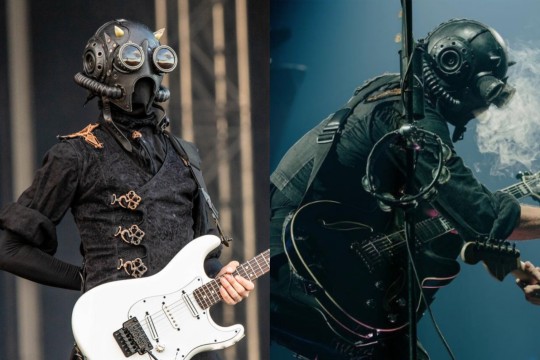
The shirts were not custom made for the ghouls, altho they were altered. The original shirt in the vintage painter linen shirt from Punk Rave and it is still being sold. Some of the cuffs were altered, removing the ruffles for some of the ghouls, but not all. They were removed for Dew, Mountain and Phantom, Aether's didn't have them either. As far as I can tell, all the ghoulettes still have them.
An unfinished piece of linen serves as an ascot, that piece is decorated with a metal devil skull. The colour of the skull doesn't appear to be consistent between each ghoul, Dew's looks gold almost bronze while Phantom's is a silver-like colour.
Another modification is the buttons, a small portion of them were removed in favor of our Impera buttons. Some of the ghouls have more buttons replaced than others, which is still a mystery to me.

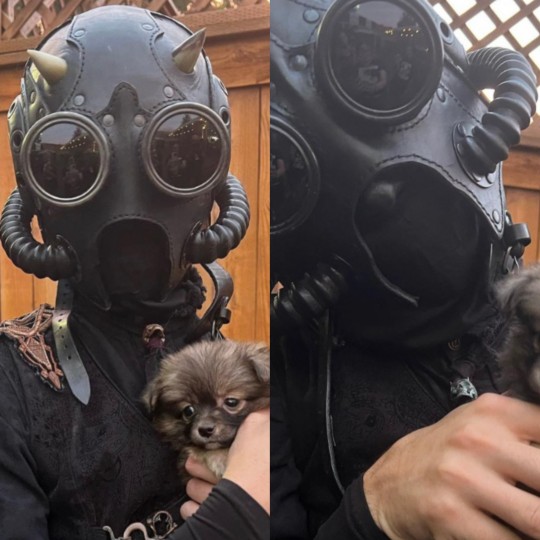
The pants are called Jodhpurs, they were invented in the 1800s as horse riding pants. The wide part at the hips and thighs allowing for better movement. The ones the ghouls wear don't reach all the way to their ankles, they stop a bit past the calf muscle, hidden by the boots. (Yes, the ghouls are effectively wearing capri pants)
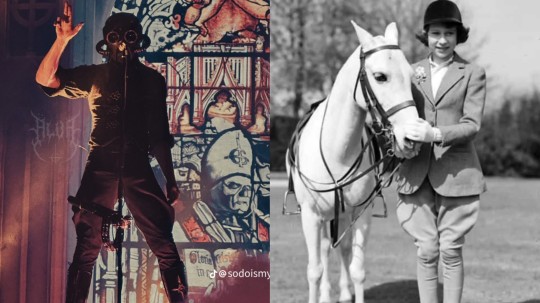
The boots are motorcycle riding boots, decorated by a grucifix. Like the shirt, they can still be bought online through the All American Boots website, altho the price tag is... Headache inducing to say the least.

The cape is a piece of costume that was only briefly worn on stage by the ghouls, Aurora being the only one who still wears one. I would assume it gets in the way of playing very easily. The cape itself is made of two fabrics, a light blue satin and a dark grey suede. The two pieces are not sewn together at the bottom, they move freely from each other. The cape is attached on the left shoulder with a harness piece that has one strap across the chest, decorated with a metal buckle, and one under the armpit.
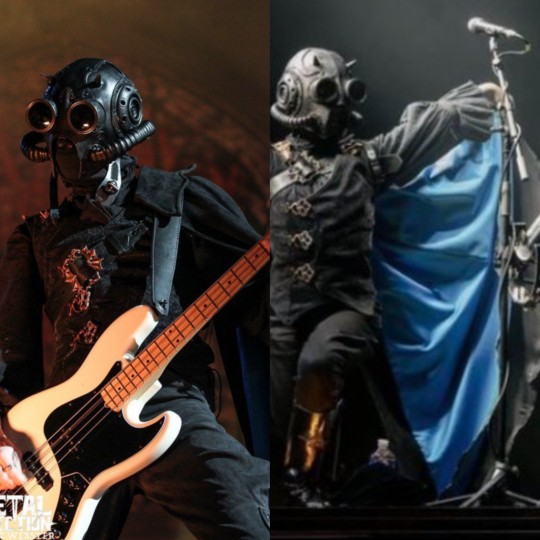
Aight that's it for me, have a nice day byyyyye!!
#the band ghost#ghost bc#nameless ghoul#nameless ghouls#swiss ghoul#phantom ghoul#swiss ghost#dewdrop ghost#rain ghost#mountain ghoul#mountain ghost#rain ghoul#phantom ghost#dewdrop ghoul#cirrus ghoulette#aurora ghoulette#cumulus ghost#aether ghost#aeon ghoul#impera ghoul#impera#meerkat talks about ghost costumes#IMPERA FIT MASTER POST LET'S GOOOO
2K notes
·
View notes
Text
Minoan Heanos
The distinctive open-front dresses worn by Minoan women are probably even more iconic than the multi-layered kilts. Over time, there's dispute whether the garment is one piece or a separate bodice and skirt, but currently the one-piece theory is in ascendance.

The word heanos is derived from the Linear B logogram *146, wehanos. The wes- prefix, which is the squiggle in the middle, indicates a garment. Bernice Jones believes that this logogram represents the garment worn by Minoan men and women.
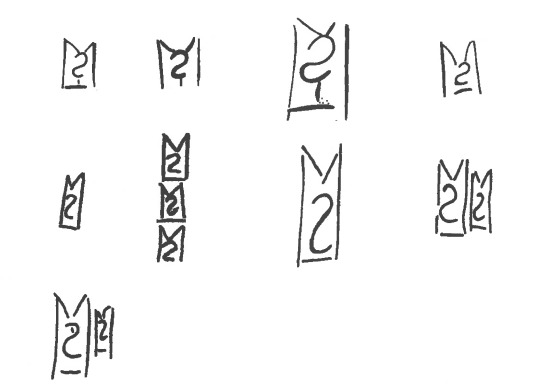
Marie-Louise B. Nosch, The Textile Logograms in the Linear B Tablets, pp 133-138
More research and construction below the cut:
The theory that the garment is a full-length tunic is further supported from imagery from the time, like these figures from the c. 1400 BCE Hagia Triada Sarcophagus. This detail from the sarcophagus shows three figures in some kind of procession, 2 women and 1 man. The woman at left wears a tunic with some kind of pelt as a skirt, and the other 2 figures wear tunics without anything over them, showing that they are one continuous, ankle-length garment.
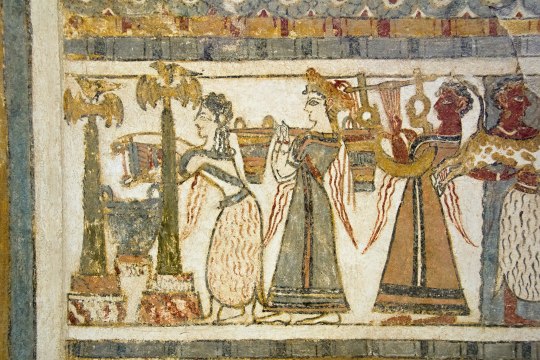
Some of the most important resources for interpreting how the heanos was constructed comes from the two women depicted in the House of the Ladies in Akrotiri, wherein the side seams of the tunic are clearly visible running along the side of the body and under the arm.
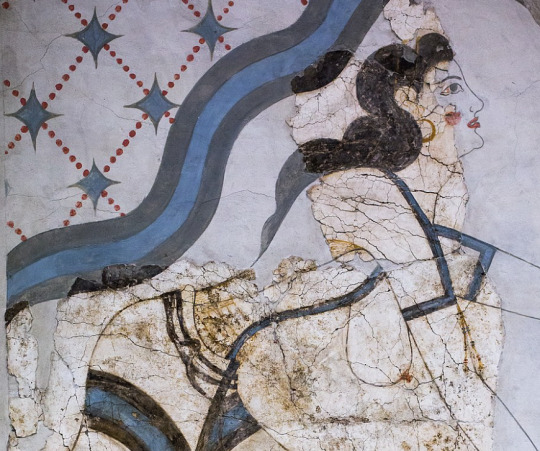
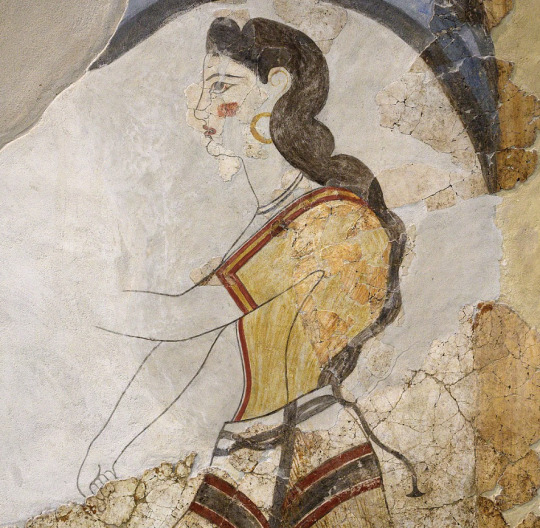
details of figures from the House of the Ladies, Akrotiri, via Wikimedia Commons
advadbsvasb
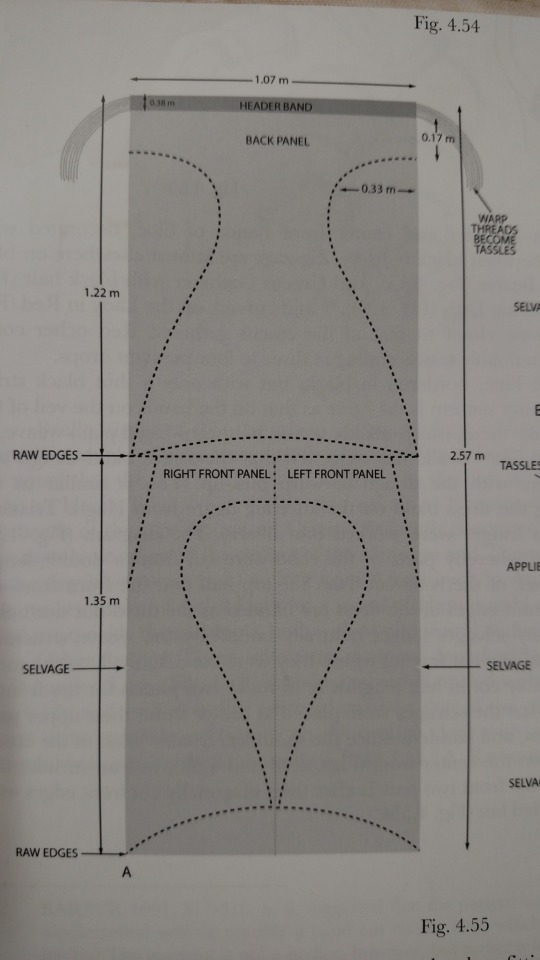

Diagrams from Bernice Jones' book Ariadne's Threads, p. 82, via Gorgeous Tangents
The heanos itself is made of 3 pieces of fabric: 1 back and 2 fronts. These diagrams show a concave hem like on the labrys-shaped kilt but I went with a straight hem, which is an equally valid option. The end of the sleeves are level with the edge of the hem at the widest point. This would probably be the width selvage-to-selvage on the fabric, being narrower than fabric widths commonly are today. There are 4 seams: the shoulder seam, the two side seams, and a front seam (optional, but recommended if you would prefer not being arrested.) It may be tempting to fold the fabric across the shoulder, so the only sewing is side seams and a neck hole, but this makes a weaker garment overall. I used this as a shortcut in my fitting muslin and it caused tears and weak points at the three points of the front opening.

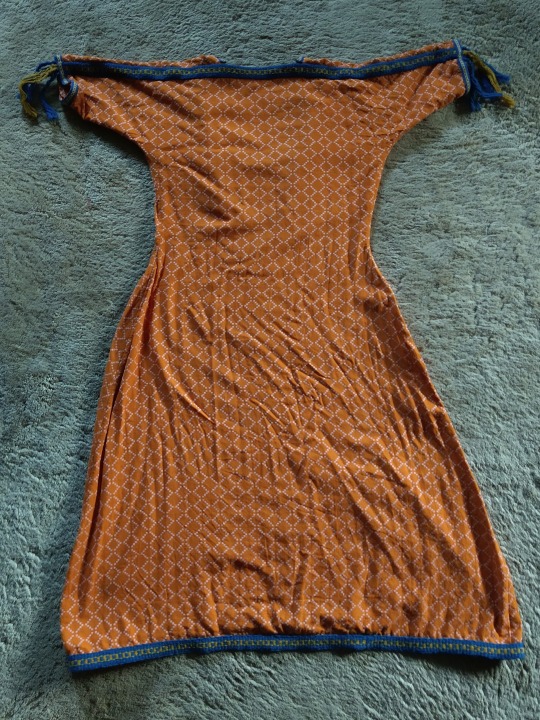
my fabric was a lightweight, moderately loose-woven cotton with a supplementary weave pattern in squares and diamonds. Linen or wool would have been more accurate but also? much harder to find from online quilting stores selling fabric for affordable prices. The main fabric is dark orange and the pattern is made out of pink/lilac threads. This weaving technique resulted in a LOT of long floats (unsecured expenses of thread) on the back--you can see how the wrong side of the fabric is much pinker than the right side. These floats could snag easily if I wasn't careful, so while it made a very effective visual for this tunic, I do not think that this fabric type would be viable for everyday wear. I'll leave it to people who actually know about weaving to ponder what more accurate weaving techniques would be.
Construction
The overall pattern is basically a T-shaped tunic, and the most important measurements are shoulder circumference, shoulder width, bust circumference, and the shoulder-waist length. In addition, you need measurements for the bicep, waist, shoulder-navel length, and hip circumference. After working out the fit with a muslin, I ended up with this pattern, 1 of 4 identical quarters.

Your first impulse may be to make the tunic very close-fitting, since the depictions in frescoes are skin-tight, but since the pattern has no added gusset this is a recipe for Cannot Move Arm. So I gave a very generous curve under the arm, which also made the dress look better when my arms were down, avoiding armpit wrinkles. I continued that ease into about an extra 2 inches added on to my waist measurement and plenty of extra space around my hips so that I could do exciting things like Sit Down.

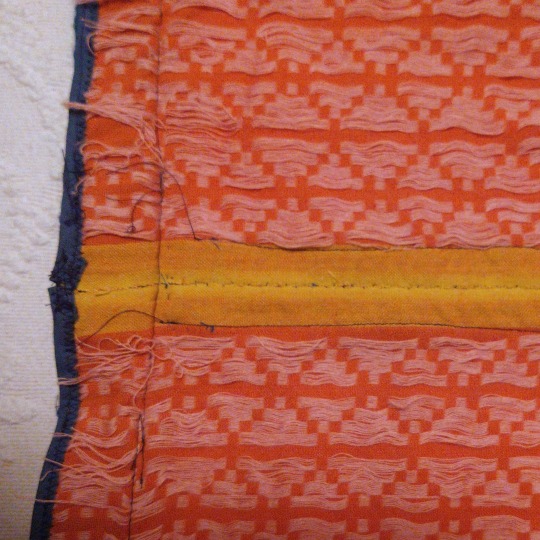
I sewed the shoulder and side seams using the machine, and felled the raw edges on each side of the seam by hand with a whipstitch. I foided back the front edges of the v-neck instead of cutting them, which was a tip I got from the Gorgeous Tangents blog. This strengthens the neckline and keeps it from stretching, and also means that everything can be readjusted if you have size fluctuations or just want to modify the tunic into something more or less modest.
I whipstitched the front edges together by hand--the contrasting selvage didn't matter because it would be covered up by trim. I ended up cutting the tunic a liiiittle shorter than I wanted, so I finished it with some leftover bias binding instead of hemming it to conserve as much length as possible.
Trim
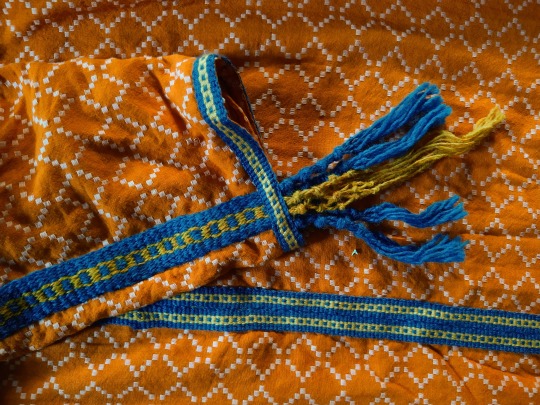
I custom-ordered the woven tape trim from Long Creek Mercantile. Both are made of wool--the "header band" and the hem trim are 1 1/4" wide and the center-front and cuff trim are 3/8" wide. I observed that most images of the Minoan heanos show trim with two colors at most, in a simple geometric or linear pattern, so I consciously restrained myself from ordering anything more elaborate. The clothing on Minoan frescoes is characterized by strongly contrasting colors, so blue trim was the most obvious, and best-looking option. Orange tunics with blue trim appear multiple time in art like the "Dancing Lady" fresco from Knossos:
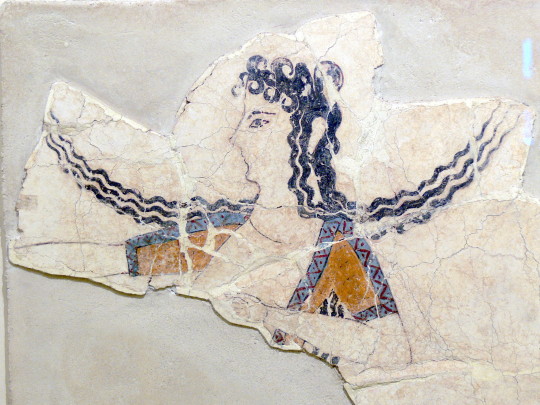
Dr. Jones suggests that the band across the shoulder would historically have been a header band--a band of threads woven at the beginning of a project in order to properly space the warp bands (see her diagram at the beginning). That may be a reason why the shoulder trim often depicted under the front or sleeve trim, as shown above. Regardless, the trim almost always coordinates.
I sewed on the shoulder trim by hand, the sleeve and hem trim by machine, and the center-front trim with a combination of both.
Tassels
Many frescoes from Akrotiri and Hagia Triada show the ends of the supposed header band turned into tassels. This embellishment is not universal among heanoi, as you can see from the "Dancing Lady" above, but it does add a fun little something!
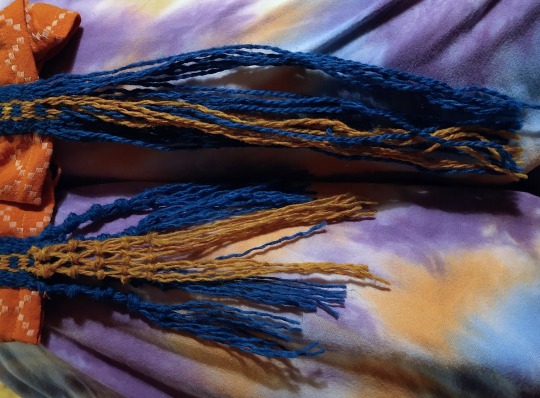
(yes, my Lounging Pants are very fashionable)
I turned the excess ends of the shoulder "header band" trim into fringes, knotting the yellow ones into a lattice and turning the blue yarns into tassels. The lattice-tassel appears on a fresco from Hagia Triada:
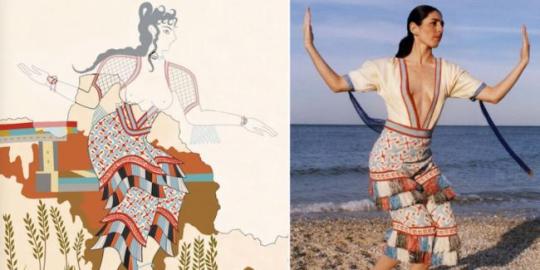
Reproduction of fragmentary fresco from Room 14 at Hagia Triada, Crete
The saffron gatherers from Akrotiri shown below have clearly displayed fringes at the ends of their sleeves. The one on the left has red fringes that appear knotted or ravelled/unravelled in an undulating pattern, and the one on the right has fringes that may be either beaded with papyrus-shaped leaves or cut into short tassels.
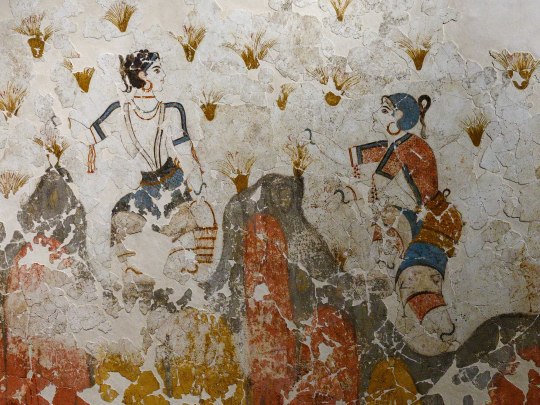
Another option is leaving the fringes loose, as seen in the Akrotiri frescoes from Xeste, room 3:
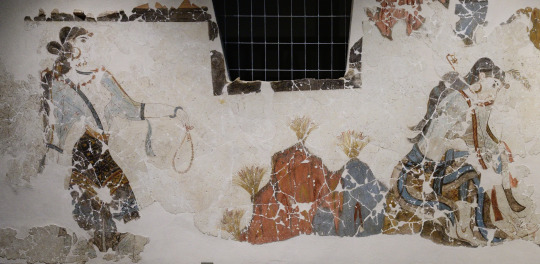
The final garment was super comfy, actually! It's much simpler to create than I thought it would be based on the frescoes, which made it all feel pretty magical when everything came together. I did think it was a little unusual how tailored this garment is, and the potential waste of fabric that comes from a shaped garment, especially compared to how later ancient greek clothing was mainly rectangles. I don't know enough about bronze-age and earlier clothing to have any idea how typical this was, since I'm extremely Not an expert on this subject, but am always open to learning more!
511 notes
·
View notes
Text
Hyakíntha Day 1 Ritual Guide: Mourning and Preparation
1. Ceremonial Garments
The following is a recommendation, it is the choice of each worshipper what they wear throughout their day and during ritual.
Much like the modern western funeral rites of today, it was traditional for the ancients to wear dark colors when grieving. On this day of mourning wear dark colors or shades of black to mourn the passing of Lord Hyacinthus.
No jewelry or adornments are to be worn (save for those worn as part of an oath to the divine). Hair should be pulled up and heads should be covered or veiled.
2. Khernips & Purification
In the morning you should cleanse your physical body in whatever way is possible for you. Whether this is a shower - washing your face - or even just using a wipe to clean your hands - it is important to regard this day with respectful practice.
Before the ritual, it is traditional to wash ones hands with khernips (a bowl of sea water into which a flaming herb is extinguished). If sea water isn't something you have access to - mix table salt into a bowl of warm water and stir to combine.
Please note that it is perfectly acceptable to not use khernips, or to wash you hands with soap after using - or in place of - khernips.
3. Gathering at the Altar
Arrange the altar space. This should be a flat surface where you can comfortably sit or stand for the duration of the ritual.
There is no shame in sitting at a table or using a chair at your altar. Hephaestus Kyllopodiôn reminds us all that there is no shame in the need for accommodations or alterations to suit our bodies needs.
To follow along with the ritual practice, you will need:
Two candles of any kind
A cup for pouring your libation
A bowl to pour your libation into
A device through which you can play music (phone, laptop, tablet, etc.,)
Incense of any kind + an incense burner
If you do not have access to candles/incense - or cannot burn these items openly - an alternative that I have used in the past is drawing the items I do not have on a piece of paper and placing the drawing/s on my altar.
4. Opening Prayer & Deity Invocation
The ritual will start with an opening prayer to Hestia, Goddess of Hearth and Home - followed by an invocation to the God Apollo.
5. Hymns & Music
The ritual will proceed with a reading from Ovid's Metamorphese - Book Ten, subsection 'Hyacinthus' (free to read online here).
Following this reading, the song "Παῦσις" by Ancient World Music will be played in it's entirety (free to listen on YouTube here). During this time, we invite all attendees to listen to and meditate on the music. Borrowing from tradition, we also encourage attendees to lightly beat their chest to the beat of the music.
6. Libations
Certain ancient funeral rites included libations poured to the dead, consisting of milk, honey, water, wine, and other ingredients in varying quantities. For this ceremony, The Temple will be utilizing a mixture of water, honey, and white wine.
During this time, individualized prayers to Apollo and Hyacinthus are appropriate - and should be spoken before or during the pouring of the libation into the ceremonial bowl.
7. Divination
Following the pouring of libations, ritual attendees/participants are encouraged to engage in their own personal divination with Lord Apollo at this time.
8. Closing Prayers
The ritual will conclude with a closing prayer to Lord Apollo, a final lament for Lord Hyacinthus, and final offerings given to Lady Hestia.
At 7:00 pm EST we will be posting a detailed script of the ritual, and at 9:00 pm EST Hytheria Aon will be performing the ritual in his home. The Temple invites all participants, who are able, to hold their own rituals at this same time.
If you have any questions please don't hesitate to reach out.
Eirene - peace and farewell,
- The Temple of Hyacinthus.
#Hyakintha#Hyakíntha#Hyakintha Day 1#Hyacinthus#Lord Hyacinthus#Apollo#Lord Apollo#text post#the temple of hyacinthus#helpol#hellenic polytheism
32 notes
·
View notes
Note
are the outfits in VDtWOF inspired by anything in particular or generic in a way?
Thank you for the ask! I love getting these :p
I had the opportunity to borrow a historian's rare book on 14th century bohemian clothing after he heavily criticized the last game I had a big hand in, Rhythm of Triverz, for period inaccuracies. That gave me a convenient ceiling for the most advanced gowns and armour you could expect in the region at the time. Resources on this are extant online but many don't cite their sources and most good ones are maintained on individual german historians' websites, so I need to do more research on this in general, but here are my basic rules for designing their clothes:
Everyone wears long gowns. Hose were pretty rare in this period. Women might have slightly longer dresses
Everyone wears a plain "shift," a garment that's worn under the main article of clothing. This is the one that gets washed
Garments, even rich ones, are unicolour. Mixed fabrics and colours appear later.
There's very little embroidery or detailwork on regular clothing
A garment will be worn with a belt, which might be longer the higher a person's status, and a pouch carrying an eating knife and other personal items
Most people will wear a head covering. Married women will always cover their hair outdoors, other women might do so too, and all women and girls cover their hair in church. Most common hats should be bundhauben or gugel.
A garment can be worn with a contrasting cloak (blue/red is a common one)
Jewellery is occasionally ok, but no piercings (?)
Shoes as we know them are more 14th/15 century; no big boots. Most shoes will be more like pointed leather socks or for ladies silk slippers. Poor people might wear wooden clogs.
No or very few fancy cuts. Later on you see tunics and gugel with with triangular or even fancier hems; This possibly exists very rarely in a limited capacity on things like a noblewoman's 'Kruseler' veil at this time, but that's probably it.
No black. No one depicted in this comic would be rich enough to waste money on black dye. Nuns and so on wear undyed or brown wool.
Military clothing is more "primitive" than might be expected. Not really any fancy visor helmets or big articulated suits of armour yet, most men-at-arms and even knights wear a mail shirt and a surcoat
As I understand, and I'm more than happy to be corrected on any of this, this applies almost universally. Peasants working in the field will wear dyed colourful garments, not plain rags. If it's hot, you don't take the outer garment off, you tuck the front hem of it in your belt to expose the shift. Masons will climb ladders and haul stone in this stuff. Some labourers or craftspeople will wear an apron and other specialized clothing like a toolbelt, too.

Note how Vesna wears a plain linen shift under her nicer yellow dress. I usually draw her with the sleeves all the way at the wrist, which would be the appropriate way to wear them, but she has it folded back here to make the composition nicer.

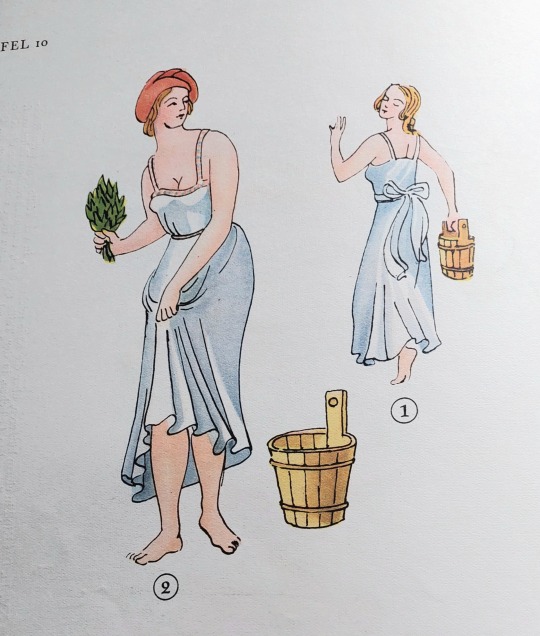
Bonus: Amusing pictures of King Václav IV slaying (150 years after when Vesna is set) and the "work uniform" of a bathhouse maid
31 notes
·
View notes
Text

Women’s Fashion: Samadidi and Diksha Saini’s Exclusive Collaboration
Innovative Fusion: Samadidi and Diksha Saini Partner Up
Samadidi.com, a leading manufacturer specializing in ready-made garments for women, has recently announced a groundbreaking collaboration with the esteemed fashion designer, Ms. Diksha Saini, hailing from Chandigarh. This strategic alliance is poised to redefine the landscape of women’s fashion, merging the manufacturing proficiency of Samadidi.com with Ms. Saini’s unparalleled design expertise.

#kurti dupatta set for women#pant kurti set with dupatta#Indian traditional dress for ladies#Online kurtis for women#traditional wear of india#Sama didi#sama garments
0 notes
Text
I keep imagining Julian, on post-war but pre-reconstruction Cardassia, pulling long shifts the rubble as they make clinics out of tents and get the hospitals back online and everyone is delirious and shell shocked as the aid pours in and Julian has forgotten entirely to tell Garak that he hasn't left the planet
right up until the women (girls, students) he's been working long hours with decide they're dressing up on their night off and Julian ends up with a face full of mostly tasteful blue make up (because the Cardassian equivalent to a lady in red HAS to be lady in blue) and wearing some very ad hoc slinky blue garment before heading to whatever the Imperial Plaza's answer to the Hawk and Dove is
where Garak is busy getting shit-faced after a long day of trying to keep the world from falling apart and thinks he's hallucinating
119 notes
·
View notes
Text
Why Jones India is the Best Choice for clothing factory in India?

Jones India: A Legacy of Excellence in Clothing Manufacturing
In the bustling city of Erode, Jones India has built a legacy as one of the best clothing factory in India. From humble beginnings, our clothing factory has grown to become a trusted name in the fashion industry. Known for our commitment to quality and attention to detail, we have established ourselves as a go-to manufacturer for both national and international clients. Our factory is equipped with state-of-the-art technology and skilled workers, ensuring that every garment we produce meets the highest standards of craftsmanship.
At Jones India we understand the importance of keeping up with the latest trends. That’s why we specialize in creating trendy clothes that are stylish, comfortable, and in line with what today’s fashion-conscious consumers want. Our design team works tirelessly to stay ahead of the curve, researching global trends and incorporating them into every collection. Whether it's bold colors, unique patterns, or cutting-edge designs, we make sure our clothes are always on point, making your brand stand out in a crowded market.
Our expertise goes beyond just creating fashionable garments; we also specialize in the art of design clothes. From conceptualization to production, we collaborate closely with our clients to bring their unique visions to life. Whether you're launching a new collection or looking for custom-made designs, our team ensures that each piece reflects the essence of your brand. We offer personalized solutions to meet your specific needs, helping you create clothing that tells a story and resonates with your audience.
In addition to our manufacturing prowess, we offer incredible value through our clothes sale options. As a leading manufacturer, we provide wholesale prices that allow retailers and brands to stock up on high-quality garments at competitive rates. Our clients can take advantage of bulk orders, discounts, and attractive deals, ensuring that they always have access to the best products at the best prices. At Jones India, we combine quality, style, and affordability to help you succeed in the fast-paced world of fashion.
#clothing manufacturer#clothing shop#kid clothes#clothing producers#clothing manu#shop cloth#shops with clothes#kiddies clothing#clothes sale#clothing factory#design clothes#trendy clothes#stitch clothes#clothing design#online boutiques#online shops#dress store#cloth shop#and online shopping#clothes bags#online shopping sale#online clothes sale#wear clothes#cloth manufacturer#garments shop#on line shops#indian clothes manufacturer#season clothing#online shopping for ladies clothes#clothes and shopping
0 notes
Text
There seems to be some debate in the historical costuming community about whether Edwardian "combinations" were intended to be worn under or over the corset. Most people I've seen on YouTube seem to be of the opinion that they should be worn "under." I... Disagree. 😅 Respectfully!
My first and most important reason is that, when I see this garment mentioned in primary sources such as the Delineator Magazine, it is listed as a "combination drawers and corset cover." (Emphasis mine) Why would they call it a "corset cover" if it wasn't intended to cover the corset?
Secondly, most of these garments have design features at the waistline that would be not only pointless but uncomfortable worn under a corset! Blousy gathers, tucks, ribbons, buttons, lace beading... All work towards giving the proper shape OVER a corset, but would add unnecessary bulk and discomfort underneath. Why would you want all that stuff being pressed into your skin for no reason?
The main visual evidence for drawers being worn under the corset seems (as far as my own observation goes) to be corset advertisements and "French" (read: softcore pornographic) postcards. And that IS visual evidence from a primary source! HOWEVER. I would argue that those particular sources are not particularly concerned with either realism or the comfort of the wearer!
So, you might ask, what DID ordinary people wear under their corsets if not "combinations"? Well, again looking at primary sources, one option would be the old-fashioned chemise, which CAN be worn tucked into drawers! This is another debate that I think mostly comes down to one's personal preference, but I have always worn my chemise UNDER my drawers, and I don't find it uncomfortable or that it interferes with using the open drawers at all (in fact, it adds an extra layer of "insurance" back there, haha!) Another option, perhaps most common by this time, is close-fitting knitted underwear, which is advertised all over publications of the period and has pages dedicated to it in the mail-order catalogs such as "Sears & Roebuck" in the U.S. and "T. Eaton's" in Canada. (Both catalogs can be studied online!) Long underwear "Union suits" were VERY popular for all ages and genders during the colder months, and on the ladies pages you also see knitted "vests" which look like long tank tops. What a perfect low-bulk option for wearing under a corset! ;-) (also knee-length knitted "combinations" that I DO think were also intended to be worn underneath the corset)
Now, here's the thing: people likely did and always WILL wear their underwear whichever way is more comfortable for them, personally! I don't think there's any one "rule" for how EVERYONE did it. But I often see a certain order of layers presented as the DEFAULT of "how they wore it," and I wanted to emphasize that it is NOT, in fact, that simple, when you look at the evidence.
#Fashion history#Historical costuming#Edwardian#Corsets#(I GUESS... 😂)#I might post pictures later if I have time!#Also I am definitely not the first or only person to say this! I am simply adding my voice to theirs
10 notes
·
View notes
Text

0 notes
Text
A "cousin" to my post that has some knitting projects I've worked on recently. Knitting is a lot easier to take pictures of, so my sewing examples are a bit...unrefined.
Most recently, the Busy Bee Quilt by Elisabeth Demoo (brownbirddesigns on IG). This was a baby shower gift for my cousin, who is having the first baby of the family!




I ended up tie-quilting it, but instead of using the same color throughout, I changed the tie color to match the piecework! At first I was...sad that I didn't have time to quilt it regularly, but I love how this method turned out. Used a surgeon knot throughout, every 4" in a grid + every 4" around the border. Scrappy bias binding, which I wouldn't have ever thought of had my LQS ladies suggested it :)
Out of the entire quilt top, only a few points don't match up. That was something I considered a priority in this project, and I'm happy I could achieve it. 11am-11pm schedule, from start to finish it took me maybe 3 weeks.

I recently decided to experiment with Canadian smocking, my second attempt (lattice) shown above (left: reverse; right: front). It was really fun, and the grid concept made me think of sashiko stitching. Definitely worth practicing.

The only other project I managed to get pictures of (with sewing I tend to scorch-earth my way through things, no time for WIP pics/too exhausted for pretty FO pics). This was actually the final skirt, but I had also made a complete mock-up in white muslim. I love the way hanfu garments (these are closest to zhequn) are structured, and maintain their functionality despite the fine detail that goes into them.
I am actually in the process of composing an in-depth guide on how I calculated the measurements, using both my experience with the mock-up/FO, and all that I learned online via forums; bilibili; YT; etc. Most of those resources were in Chinese, so all of the years I studied ZH (Mandarin, specifically, 北京话 even more specifically [as is fairly common within American schools]) came in handy ;;
#personal#about me#sewing#quiltblr#tie quilting#baby quilt#brownbirddesigns#canadian smocking#traditional smocking#smocking#hanfu#zhequn#褶裙#it has pockets#personal-sewing
15 notes
·
View notes